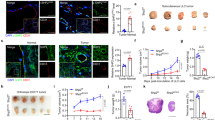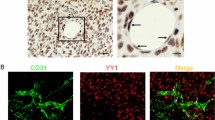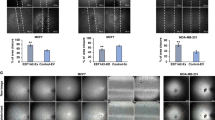Abstract
Eph receptor tyrosine kinases and their ephrin ligands have been implicated in embryonic vascular development and in in vivo models of angiogenesis. Eph proteins may also regulate tumor neovascularization, but this role has not been previously investigated. To screen for Eph proteins expressed in tumor blood vessels, we used tumor xenografts grown in nude mice from MDA-MB-435 human breast cancer cells or KS1767 human Kaposi's sarcoma cells. By immunohistochemistry, the ephrin-A1 ligand and one of its receptors, EphA2, were detected throughout tumor vasculature. Double-labeling with anti-CD34 antibodies demonstrated that both ephrin-A1 and EphA2 were expressed in xenograft endothelial cells and also tumor cells. Furthermore, EphA2 was tyrosine-phosphorylated in the xenograft tumors, indicating that it was activated, presumably by interacting with ephrin-A1. Ephrin-A1 and EphA2 were also detected in both the vasculature and tumor cells of surgically removed human cancers. In an in vitro angiogenesis model, a dominant negative form of EphA2 inhibited capillary tube-like formation by human umbilical vein endothelial cells (HUVECs), demonstrating a requirement for EphA receptor signaling. These data suggest that ephrin-A1 and EphA2 play a role in human cancers, at least in part by influencing tumor neovascularization. Eph proteins may represent promising new targets for antiangiogenic cancer treatments.
This is a preview of subscription content, access via your institution
Access options
Subscribe to this journal
Receive 50 print issues and online access
$259.00 per year
only $5.18 per issue
Buy this article
- Purchase on Springer Link
- Instant access to full article PDF
Prices may be subject to local taxes which are calculated during checkout






Similar content being viewed by others
References
Adams RH, Wilkinson GA, Weiss C, Diella F, Gale NW, Deutsch U, Risau W and Klein R. . 1999 Genes Dev. 13: 295–306.
Andres AC, Reid HH, Zurcher G, Blaschke RJ, Albrecht D and Ziemiecki A. . 1994 Oncogene 9: 1461–1467.
Asahara T, Murohara T, Sullivan A, Silver M, van der Zee R, Li T, Witzenbichler B, Schatteman G and Isner JM. . 1997 Science 275: 964–967.
Bartley TD, Hunt RW, Welcher AA, Boyle WJ, Parker VP, Lindberg RA, Lu HS, Colombero AM, Elliott RL and Guthrie BA. . 1994 Nature 368: 558–560.
Baumheter S, Singer MS, Henzel W, Hemmerich S, Renz M, Rosen SD and Lasky LA. . 1993 Science 262: 436–438.
Berclaz G, Andres AC, Albrecht D, Dreher E, Ziemiecki A, Gusterson BA and Crompton MR. . 1996 Biochem. Biophys. Res. Commun. 226: 869–875.
Bobik A, Agrotis A and Little PJ. . 1997 Tumour Angiogenesis. Bickness, R. (ed.). Oxford University Press: New York, pp. 169–184.
Brooks PC, Clark RA and Cheresh DA. . 1994 Science 264: 569–571.
Daniel TO, Sein E, Cerretti DP, St John PL, Robert B and Abrahamson DR . (1996) Kidney Int. (Suppl.,) 57: S73–S81.
Davy A, Gale MW, Murray EW, Klinghoffer RA, Soriano P, Feuerstein C and Robbins SM. . 1999 Genes Dev. 13: 3125–3135.
Dodelet VC and Pasquale EB. . 2000 Oncogene (in press).
Easty DJ, Herlyn M and Bennett DC. . 1995 Int. J. Cancer 60: 129–136.
Easty DJ, Hill SP, Hsu MY, Fallowfield ME, Florenes VA, Herlyn M and Bennett DC. . 1999 Int. J. Cancer 84: 494–501.
Eberhart J, Swartz M, Koblar SA, Pasquale EB, Tanaka H and Krull CE. . 2000 Dev. Neurosci. 22: 237–250.
Eph-Nomenclature-Committee.1997 Cell 90: 403–404.
Flanagan JG and Vanderhaeghen P. . 1998 Annu. Rev. Neurosci. 21: 309–345.
Flenniken AM, Gale NW, Yancopoulos GD and Wilkinson DG. . 1996 Dev. Biol. 179: 382–401.
Folkman J. . 1995 Nature Med. 1: 27–31.
Folkman J and D'Amore PA. . 1996 Cell 87: 1153–1155.
Fox SB, Turner GD, Gatter KC and Harris AL. . 1995 J. Pathol. 177: 369–376.
Friedlander M, Brooks PC, Shaffer RW, Kincaid CM, Varner JA and Cheresh DA. . 1995 Science 270: 1500–1502.
Gale NW and Yancopoulos GD. . 1999 Genes Dev. 13: 1055–1066.
Gasparini G. . 1997 Tumour Angiogenesis. Bicknell, R. (ed.). Oxford University Press: New York, pp. 29–43.
Gerety SS, Wang HU, Chen ZF and Anderson DJ. . 1999 Mol. Cell. 4: 403–414.
Hanahan D. . 1997 Science 277: 48–50.
Hanahan D and Folkman J. . 1996 Cell 86: 353–364.
Herndier BG, Werner A, Arnstein P, Abbey NW, Demartis F, Cohen RL, Shuman MA and Levy JA. . 1994 AIDS 8: 575–581.
Hirai H, Maru Y, Hagiwara K, Nishida J and Takaku F. . 1987 Science 238: 1717–1720.
Holash JA and Pasquale EB. . 1995 Dev. Biol. 172: 683–693.
Holzman LB, Marks RM and Dixit VM. . 1990 Mol. Cell. Biol. 10: 5830–5838.
Huynh-Do U, Stein E, Lane AA, Liu H, Cerretti DP and Daniel TO. . 1999 EMBO J. 18: 2165–2173.
Kalo MS and Pasquale EB. . 1999 Cell Tissue Res. 298: 1–9.
Kiyokawa E, Takai S, Tanaka M, Iwase T, Suzuki M, Xiang YY, Naito Y, Yamada K, Sugimura H and Kino I. . 1994 Cancer Res. 54: 3645–3650.
Lindberg RA and Hunter T. . 1990 Mol. Cell. Biol. 10: 6316–6324.
Magal E, Holash JA, Toso RJ, Chang D, Lindberg RA and Pasquale EB. . 1996 J. Neurosci. Res. 43: 735–744.
Maru Y, Hirai H and Takaku F. . 1990 Oncogene 5: 445–447.
Maru Y, Hirai H, Yoshida MC and Takaku F. . 1998 Mol. Cell. Biol. 8: 3770–3776.
McBride JL and Ruiz JC. . 1998 Mech. Dev. 77: 201–204.
Mellitzer G, Xu QL and Wilkinson DG. . 1999 Nature 400: 77–81.
Merenmies J, Parada LF and Henkemeyer M. . 1997 Cell Growth Differ. 8: 3–10.
Miao H, Burnett E, Kinch M, Simon E and Wang BC. . 2000 Nature Cell Biol. 2: 62–69.
Pandey A, Shao H, Marks RM, Polverini PJ and Dixit VM. . 1995 Science 268: 567–569.
Pasqualini R, Koivunen E and Ruoslahti E. . 1997 Nat. Biotechnol. 15: 542–546.
Price JE, Polyzos A, Zhang RD and Daniels LM. . 1990 Cancer Res. 50: 717–721.
Risau W. . 1997 Nature 386: 671–674.
Risau W and Flamme I. . 1995 Annu. Rev. Cell. Dev. Biol. 11: 73–91.
Sarma V, Wolf FW, Marks RM, Shows TB and Dixit VM. . 1992 J. Immunol. 148: 3302–3312.
Sato TN, Tozawa Y, Deutsch U, Wolburg-Buchholz K, Fujiwara Y, Gendron-Maguire M, Gridley T, Wolburg H, Risau W and Qin Y. . 1995 Nature 376: 70–74.
Soans C, Holash JA and Pasquale EB. . 1994 Oncogene 9: 3353–3361.
Soans C, Holash JA, Pavlova Y and Pasquale EB. . 1996 J. Cell Biol. 135: 781–795.
Stein E, Lane AA, Cerretti DP, Schoecklmann HO, Schroff AD, Ven Etten RL and Daniel TO. . 1998 Genes Dev. 12: 667–678.
Suri C, Jones PF, Patan S, Bartunkova S, Maisonpierre PC, Davis S, Sato TN and Yancopoulos GD. . 1996 Cell 87: 1171–1180.
Takahashi H and Ikeda T. . 1995 Oncogene 11: 879–883.
van der Geer P, Hunter T and Lindberg RA. . 1994 Annu. Rev. Cell Biol. 10: 251–337.
Walker-Daniels J, Coffman K, Azimi M, Rhim JS, Bostwick DG, Snyder P, Kerns BJ, Waters DJ and Kinch MS. . 1999 Prostate 41: 275–280.
Wang HU, Chen ZF and Anderson DJ. . 1998 Cell 93: 741–753.
Xu Q, Mellitzer G, Robinson V and Wilkinson DG. . 1999 Nature 399: 267–271.
Zisch AH, Pazzagli C, Freeman AL, Schneller M, Hadman M, Smith JW, Ruoslahti E and Pasquale EB. . 2000 Oncogene 19: 177–187.
UICC. 1997 International Union Against Cancer: TNM, Classification of Malignant Tumors. 5th edn. (eds) Sobin LH and Wittekind C. J Wiley & Sons, Inc.
Acknowledgements
The authors thank David Scadden for providing the human EphB4 cDNA; Patricia Menzel for the preparation of antibodies used in this study and Vincent Dodelet for helpful discussions and advice. This work was supported by NIH grants HD26351 and CA82713 (EB Pasquale).
Author information
Authors and Affiliations
Rights and permissions
About this article
Cite this article
Ogawa, K., Pasqualini, R., Lindberg, R. et al. The ephrin-A1 ligand and its receptor, EphA2, are expressed during tumor neovascularization. Oncogene 19, 6043–6052 (2000). https://doi.org/10.1038/sj.onc.1204004
Received:
Revised:
Accepted:
Published:
Issue Date:
DOI: https://doi.org/10.1038/sj.onc.1204004
Keywords
This article is cited by
-
Targeting EphA2: a promising strategy to overcome chemoresistance and drug resistance in cancer
Journal of Molecular Medicine (2024)
-
Regulation of the EphA2 receptor intracellular region by phosphomimetic negative charges in the kinase-SAM linker
Nature Communications (2021)
-
Plasma Ephrin-A1 level in a cohort of diabetic retinopathy patients
BMC Ophthalmology (2020)
-
Tumor angiogenesis: causes, consequences, challenges and opportunities
Cellular and Molecular Life Sciences (2020)
-
Immunohistochemical assessment of Eph/ephrin expression in oral squamous cell carcinoma and precursor lesions
Odontology (2020)



